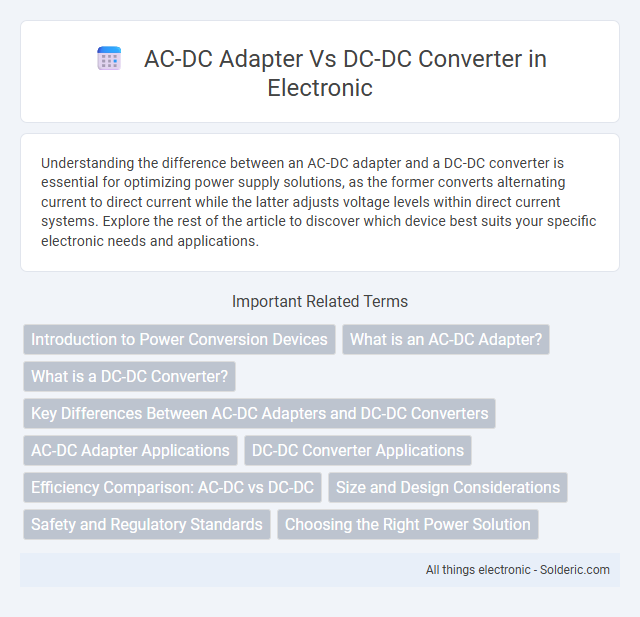Understanding the difference between an AC-DC adapter and a DC-DC converter is essential for optimizing power supply solutions, as the former converts alternating current to direct current while the latter adjusts voltage levels within direct current systems. Explore the rest of the article to discover which device best suits your specific electronic needs and applications.
Comparison Table
| Feature | AC-DC Adapter | DC-DC Converter |
|---|---|---|
| Input Voltage | Alternating Current (AC), typically 100-240V | Direct Current (DC), varies by design |
| Output Voltage | Stable DC voltage, e.g., 5V, 12V | Adjusted DC voltage, step-up or step-down |
| Function | Convert AC power to usable DC power | Convert DC voltage levels efficiently |
| Common Use | Power supply for electronic devices from mains | Power regulation within devices or systems |
| Efficiency | Typically 70-90% | Typically 80-95% |
| Size | Usually larger, includes transformer | Compact, no transformer required |
| Application Example | Chargers, power bricks | Battery-powered devices, voltage boosters |
Introduction to Power Conversion Devices
Power conversion devices like AC-DC adapters and DC-DC converters play crucial roles in transforming electrical energy to match device requirements. An AC-DC adapter converts alternating current (AC) from wall outlets into direct current (DC) suitable for electronic devices, ensuring stable voltage and current supply. DC-DC converters adjust the voltage levels of DC power within systems, optimizing efficiency and protecting sensitive components in your electronics.
What is an AC-DC Adapter?
An AC-DC adapter converts alternating current (AC) from a wall outlet into direct current (DC) suitable for powering electronic devices. It typically includes a transformer, rectifier, and regulator to provide a stable DC output voltage. Your choice of an AC-DC adapter depends on the voltage and current requirements of your device to ensure safe and efficient operation.
What is a DC-DC Converter?
A DC-DC converter is an electronic device that converts a source of direct current (DC) from one voltage level to another, either stepping up (boost) or stepping down (buck) the voltage as needed. Unlike AC-DC adapters, which convert alternating current (AC) from the mains to DC, DC-DC converters are used in battery-powered devices, automotive systems, and renewable energy applications to efficiently regulate voltage within DC circuits. Key types include buck, boost, buck-boost, and isolated converters, each designed for specific voltage transformation and efficiency requirements.
Key Differences Between AC-DC Adapters and DC-DC Converters
AC-DC adapters convert alternating current (AC) from power outlets into direct current (DC) suitable for electronic devices, while DC-DC converters modify DC voltage levels from one form to another to match specific device requirements. The main difference lies in their input sources and functions: AC-DC adapters handle AC to DC conversion, providing a stable output voltage, and DC-DC converters regulate or step up/down existing DC voltages within a system. Understanding these differences helps you select the right power component for efficient energy management in your electronics.
AC-DC Adapter Applications
AC-DC adapters are commonly used to power household electronics, laptops, and small appliances by converting mains AC voltage into regulated DC output. These adapters provide reliable and consistent power suitable for consumer devices that require stable DC voltage from an AC source. Your choice of an AC-DC adapter ensures compatibility with standard wall outlets and is ideal for applications needing direct current from alternating current sources.
DC-DC Converter Applications
DC-DC converters are essential in applications requiring voltage regulation and conversion within electronic devices, such as in battery-powered systems, telecommunications, and automotive electronics. They enable efficient power management by stepping up or stepping down DC voltage to match specific operational needs, improving energy efficiency and device performance. These converters are widely used in portable gadgets, renewable energy systems, and industrial automation where precise voltage control is critical.
Efficiency Comparison: AC-DC vs DC-DC
AC-DC adapters convert alternating current (AC) from the mains to direct current (DC) for devices, typically achieving efficiency rates between 70% to 90%, depending on design and load. DC-DC converters regulate and transform DC voltage levels within devices, reaching higher efficiency levels often exceeding 90% due to reduced energy loss during conversion. The higher efficiency of DC-DC converters plays a critical role in minimizing heat generation and power consumption in battery-powered and electronic applications.
Size and Design Considerations
AC-DC adapters typically feature larger enclosures due to the need for components like transformers and rectifiers to convert alternating current to direct current, affecting overall size and portability. DC-DC converters are generally more compact and lightweight, designed to efficiently step up or down voltage within DC systems, making them ideal for applications with strict space constraints. Your choice between these devices depends on the importance of size, with DC-DC converters offering a sleek design for integrated electronics compared to bulkier AC-DC adapters.
Safety and Regulatory Standards
AC-DC adapters comply with strict safety and regulatory standards such as UL, CE, and FCC to ensure safe conversion from alternating current to low-voltage direct current suitable for consumer electronics. DC-DC converters must also meet industry certifications, including ISO and IEC standards, to guarantee safe voltage step-up or step-down operations within electronic devices and industrial systems. Both require rigorous testing for electrical isolation, thermal performance, and electromagnetic compatibility to prevent hazards like electric shock, overheating, and interference.
Choosing the Right Power Solution
Selecting the right power solution depends on the voltage and current requirements of your application, with AC-DC adapters converting mains AC to regulated DC power, ideal for powering devices from wall outlets. DC-DC converters adjust one DC voltage level to another, offering efficiency and flexibility for battery-powered or portable electronics requiring stable voltage regulation. Understanding the input source and output specifications ensures optimal performance and energy efficiency in your power supply design.
AC-DC adapter vs DC-DC converter Infographic

 solderic.com
solderic.com